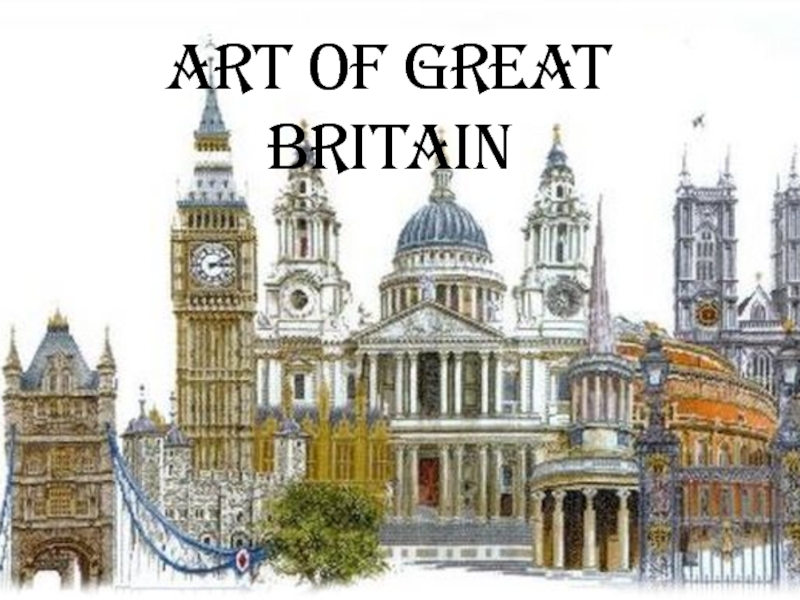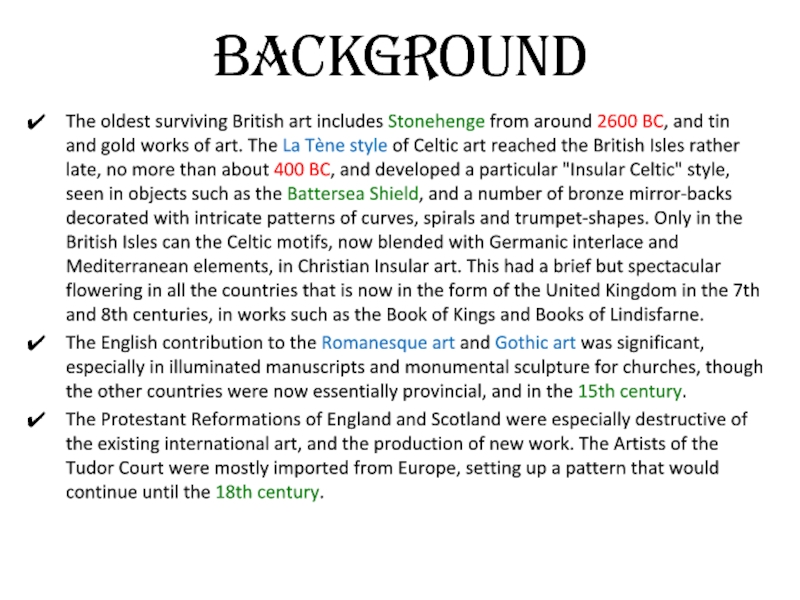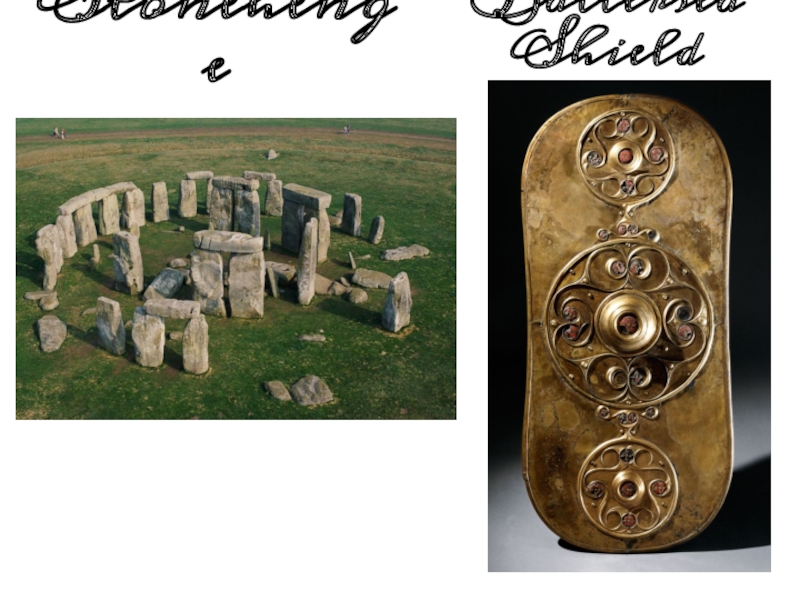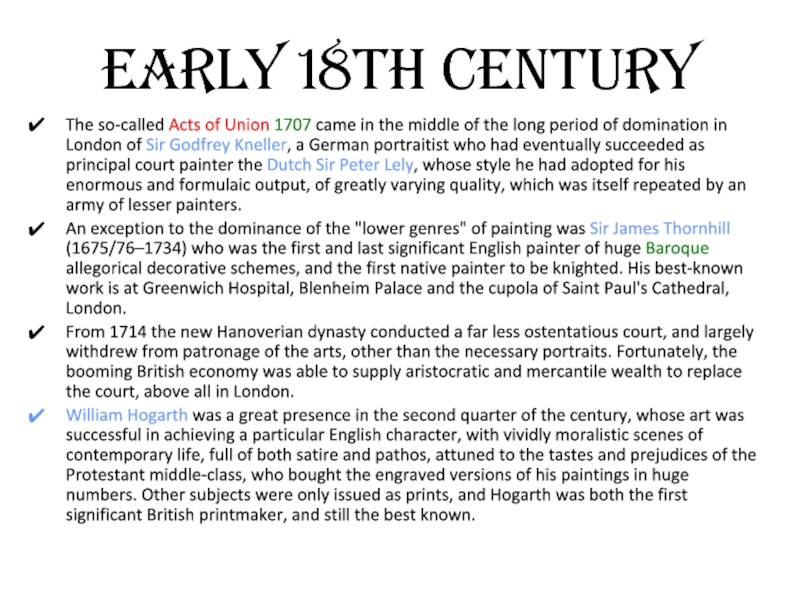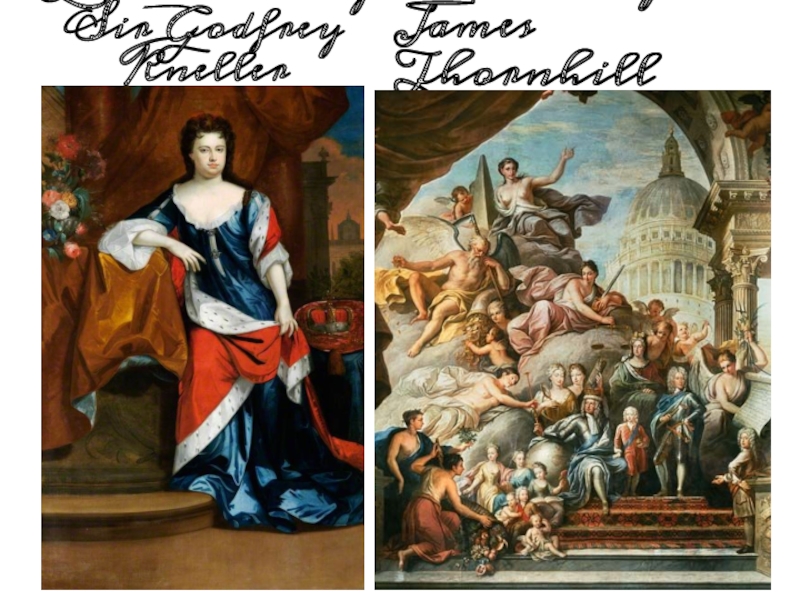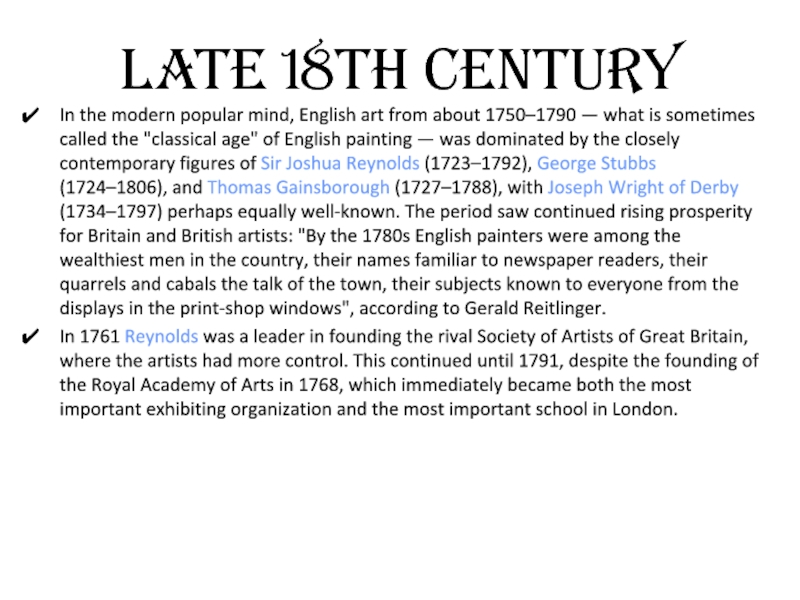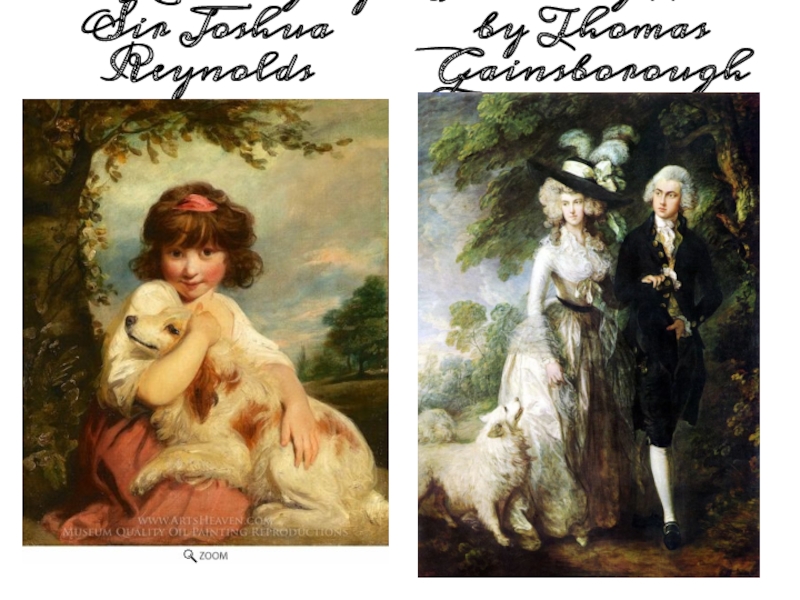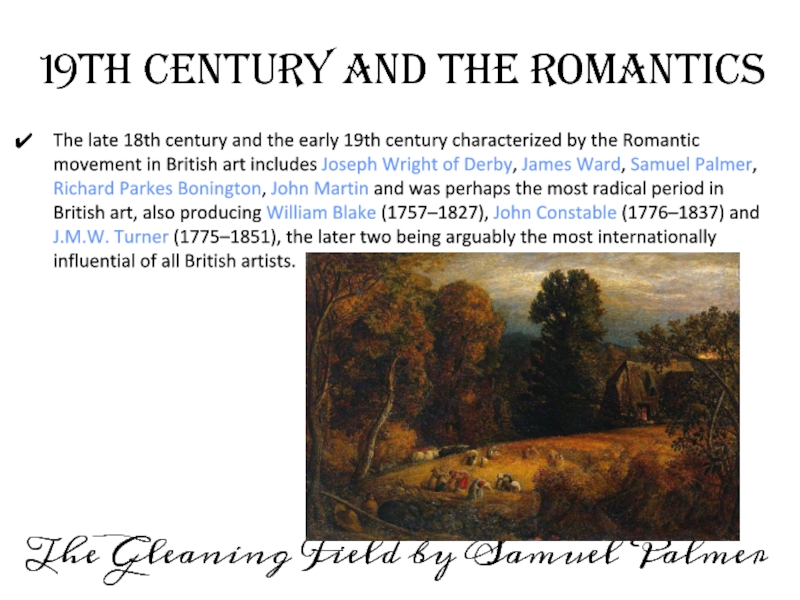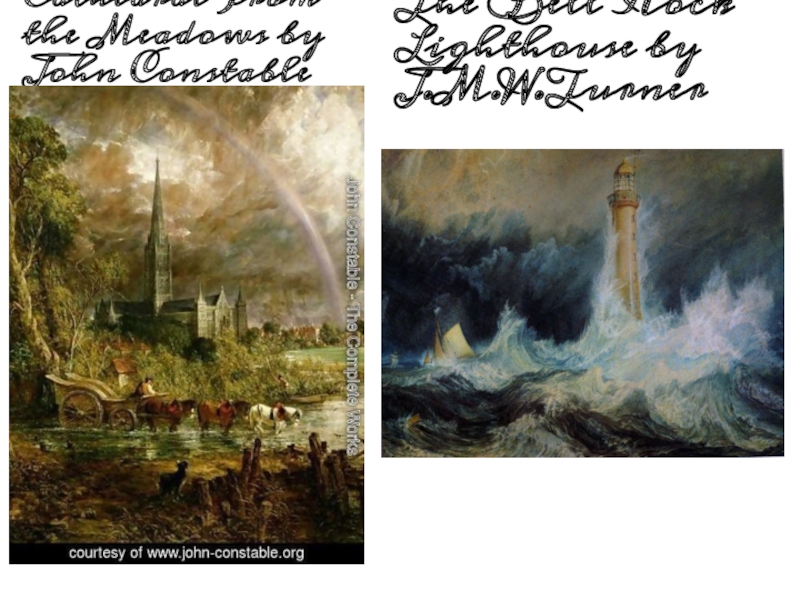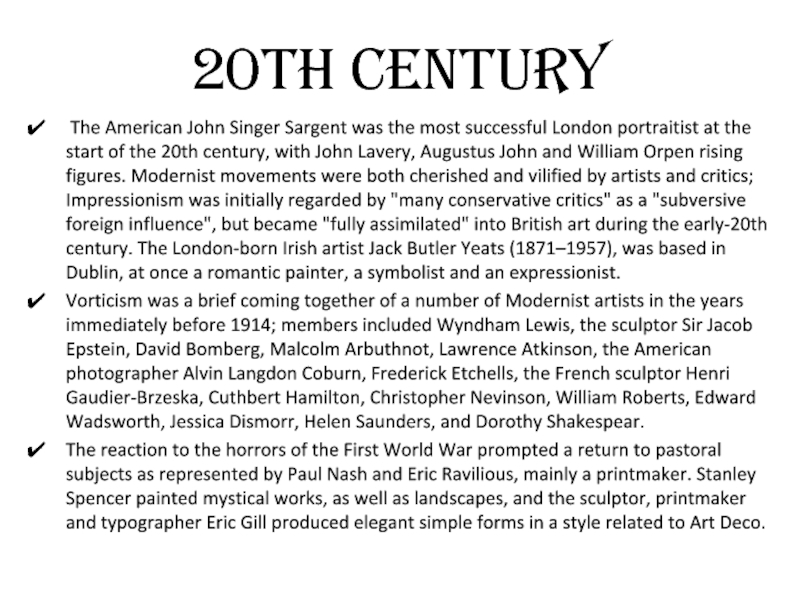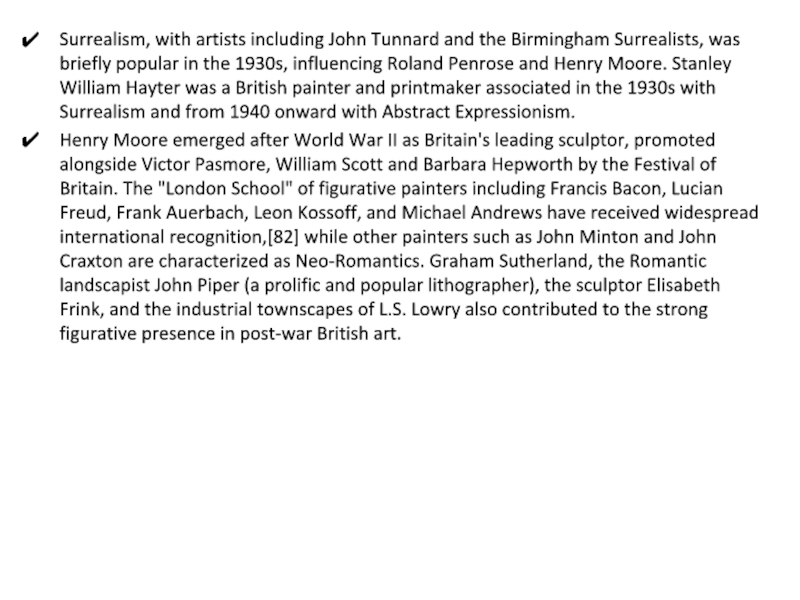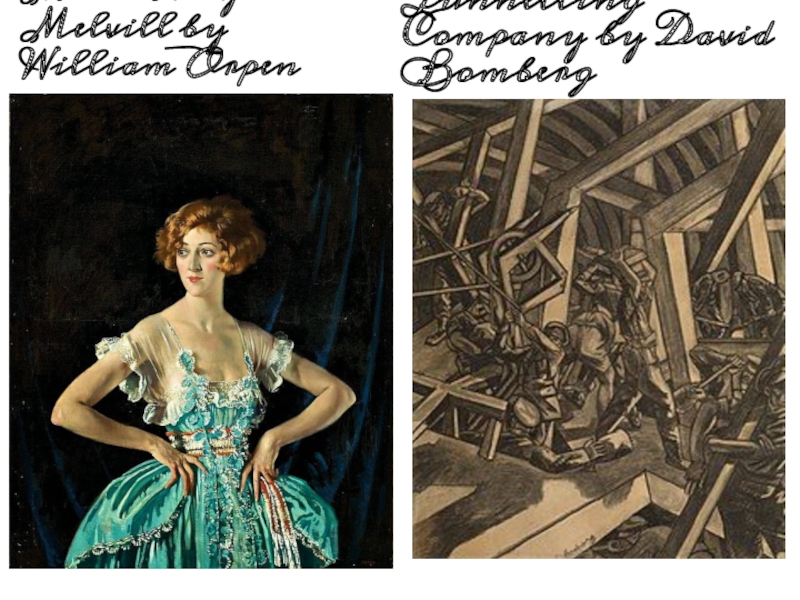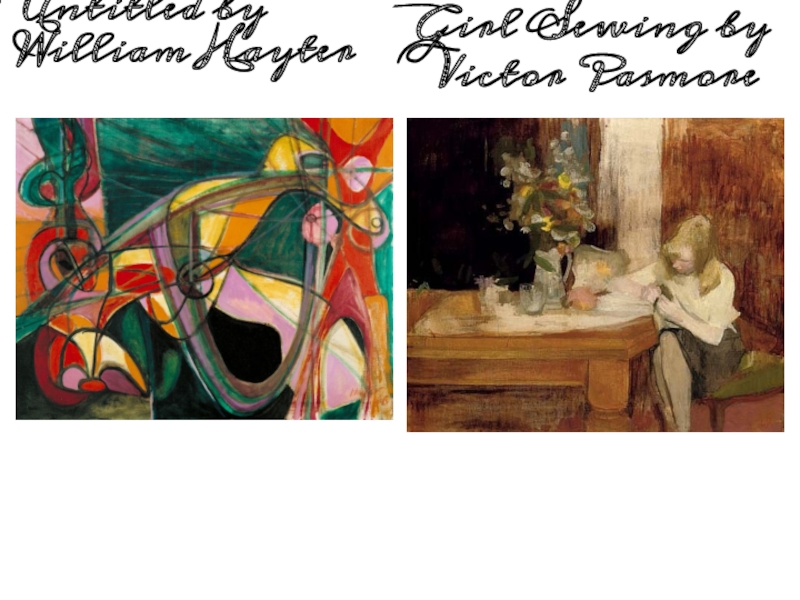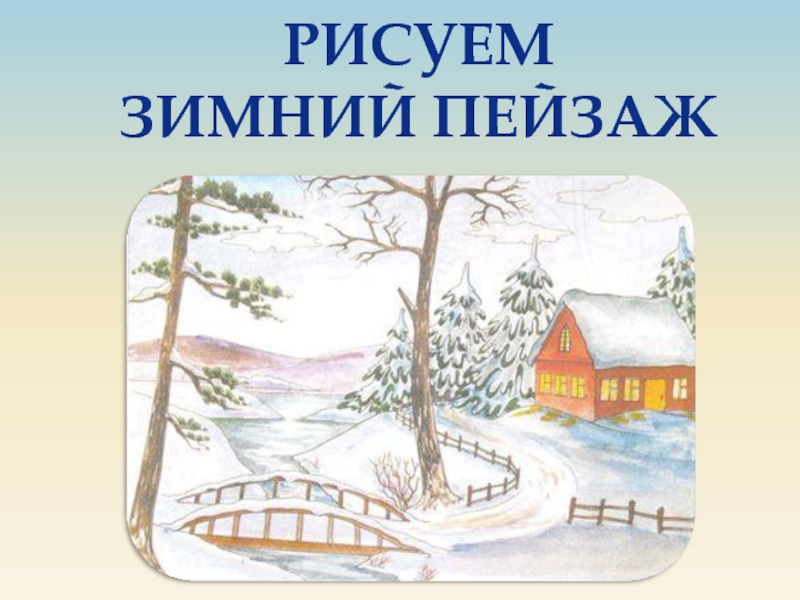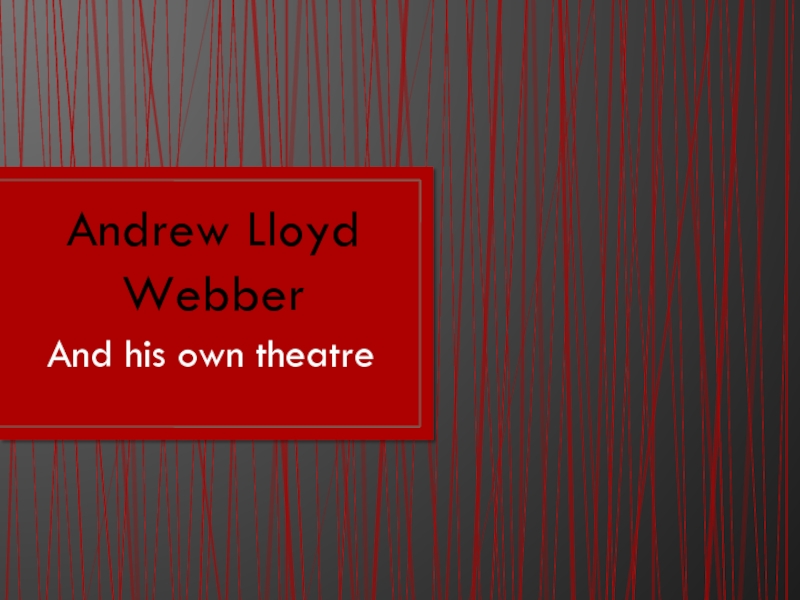- Главная
- Разное
- Дизайн
- Бизнес и предпринимательство
- Аналитика
- Образование
- Развлечения
- Красота и здоровье
- Финансы
- Государство
- Путешествия
- Спорт
- Недвижимость
- Армия
- Графика
- Культурология
- Еда и кулинария
- Лингвистика
- Английский язык
- Астрономия
- Алгебра
- Биология
- География
- Детские презентации
- Информатика
- История
- Литература
- Маркетинг
- Математика
- Медицина
- Менеджмент
- Музыка
- МХК
- Немецкий язык
- ОБЖ
- Обществознание
- Окружающий мир
- Педагогика
- Русский язык
- Технология
- Физика
- Философия
- Химия
- Шаблоны, картинки для презентаций
- Экология
- Экономика
- Юриспруденция
ART of Great Britain презентация
Содержание
- 1. ART of Great Britain
- 2. Background The oldest surviving British art includes
- 3. Stonehenge Battersea Shield
- 4. Early 18th century The so-called Acts of
- 5. Queen Anne by Sir Godfrey Kneller House of Hanover by Sir James Thornhill
- 6. Late 18th century In the modern popular
- 7. A Young Girl and Her Dog by Sir Joshua Reynolds Morning Walk by Thomas Gainsborough
- 8. 19th century and the Romantics The late
- 9. Salisbury Cathedral From the Meadows by John Constable The Bell Rock Lighthouse by J.M.W.Turner
- 10. 20th century The American John Singer
- 11. Surrealism, with artists including John Tunnard and
- 12. Mrs. Ruby Melvill by William Orpen A Canadian Tunnelling Company by David Bomberg
- 13. Untitled by William Hayter Girl Sewing by Victor Pasmore
Слайд 2Background
The oldest surviving British art includes Stonehenge from around 2600 BC,
and tin and gold works of art. The La Tène style of Celtic art reached the British Isles rather late, no more than about 400 BC, and developed a particular "Insular Celtic" style, seen in objects such as the Battersea Shield, and a number of bronze mirror-backs decorated with intricate patterns of curves, spirals and trumpet-shapes. Only in the British Isles can the Celtic motifs, now blended with Germanic interlace and Mediterranean elements, in Christian Insular art. This had a brief but spectacular flowering in all the countries that is now in the form of the United Kingdom in the 7th and 8th centuries, in works such as the Book of Kings and Books of Lindisfarne.
The English contribution to the Romanesque art and Gothic art was significant, especially in illuminated manuscripts and monumental sculpture for churches, though the other countries were now essentially provincial, and in the 15th century.
The Protestant Reformations of England and Scotland were especially destructive of the existing international art, and the production of new work. The Artists of the Tudor Court were mostly imported from Europe, setting up a pattern that would continue until the 18th century.
The English contribution to the Romanesque art and Gothic art was significant, especially in illuminated manuscripts and monumental sculpture for churches, though the other countries were now essentially provincial, and in the 15th century.
The Protestant Reformations of England and Scotland were especially destructive of the existing international art, and the production of new work. The Artists of the Tudor Court were mostly imported from Europe, setting up a pattern that would continue until the 18th century.
Слайд 4Early 18th century
The so-called Acts of Union 1707 came in the
middle of the long period of domination in London of Sir Godfrey Kneller, a German portraitist who had eventually succeeded as principal court painter the Dutch Sir Peter Lely, whose style he had adopted for his enormous and formulaic output, of greatly varying quality, which was itself repeated by an army of lesser painters.
An exception to the dominance of the "lower genres" of painting was Sir James Thornhill (1675/76–1734) who was the first and last significant English painter of huge Baroque allegorical decorative schemes, and the first native painter to be knighted. His best-known work is at Greenwich Hospital, Blenheim Palace and the cupola of Saint Paul's Cathedral, London.
From 1714 the new Hanoverian dynasty conducted a far less ostentatious court, and largely withdrew from patronage of the arts, other than the necessary portraits. Fortunately, the booming British economy was able to supply aristocratic and mercantile wealth to replace the court, above all in London.
William Hogarth was a great presence in the second quarter of the century, whose art was successful in achieving a particular English character, with vividly moralistic scenes of contemporary life, full of both satire and pathos, attuned to the tastes and prejudices of the Protestant middle-class, who bought the engraved versions of his paintings in huge numbers. Other subjects were only issued as prints, and Hogarth was both the first significant British printmaker, and still the best known.
An exception to the dominance of the "lower genres" of painting was Sir James Thornhill (1675/76–1734) who was the first and last significant English painter of huge Baroque allegorical decorative schemes, and the first native painter to be knighted. His best-known work is at Greenwich Hospital, Blenheim Palace and the cupola of Saint Paul's Cathedral, London.
From 1714 the new Hanoverian dynasty conducted a far less ostentatious court, and largely withdrew from patronage of the arts, other than the necessary portraits. Fortunately, the booming British economy was able to supply aristocratic and mercantile wealth to replace the court, above all in London.
William Hogarth was a great presence in the second quarter of the century, whose art was successful in achieving a particular English character, with vividly moralistic scenes of contemporary life, full of both satire and pathos, attuned to the tastes and prejudices of the Protestant middle-class, who bought the engraved versions of his paintings in huge numbers. Other subjects were only issued as prints, and Hogarth was both the first significant British printmaker, and still the best known.
Слайд 6Late 18th century
In the modern popular mind, English art from about
1750–1790 — what is sometimes called the "classical age" of English painting — was dominated by the closely contemporary figures of Sir Joshua Reynolds (1723–1792), George Stubbs (1724–1806), and Thomas Gainsborough (1727–1788), with Joseph Wright of Derby (1734–1797) perhaps equally well-known. The period saw continued rising prosperity for Britain and British artists: "By the 1780s English painters were among the wealthiest men in the country, their names familiar to newspaper readers, their quarrels and cabals the talk of the town, their subjects known to everyone from the displays in the print-shop windows", according to Gerald Reitlinger.
In 1761 Reynolds was a leader in founding the rival Society of Artists of Great Britain, where the artists had more control. This continued until 1791, despite the founding of the Royal Academy of Arts in 1768, which immediately became both the most important exhibiting organization and the most important school in London.
In 1761 Reynolds was a leader in founding the rival Society of Artists of Great Britain, where the artists had more control. This continued until 1791, despite the founding of the Royal Academy of Arts in 1768, which immediately became both the most important exhibiting organization and the most important school in London.
Слайд 819th century and the Romantics
The late 18th century and the early
19th century characterized by the Romantic movement in British art includes Joseph Wright of Derby, James Ward, Samuel Palmer, Richard Parkes Bonington, John Martin and was perhaps the most radical period in British art, also producing William Blake (1757–1827), John Constable (1776–1837) and J.M.W. Turner (1775–1851), the later two being arguably the most internationally influential of all British artists.
The Gleaning Field by Samuel Palmer
The Gleaning Field by Samuel Palmer
Слайд 9Salisbury Cathedral From the Meadows by John Constable
The Bell Rock Lighthouse
by J.M.W.Turner
Слайд 1020th century
The American John Singer Sargent was the most successful
London portraitist at the start of the 20th century, with John Lavery, Augustus John and William Orpen rising figures. Modernist movements were both cherished and vilified by artists and critics; Impressionism was initially regarded by "many conservative critics" as a "subversive foreign influence", but became "fully assimilated" into British art during the early-20th century. The London-born Irish artist Jack Butler Yeats (1871–1957), was based in Dublin, at once a romantic painter, a symbolist and an expressionist.
Vorticism was a brief coming together of a number of Modernist artists in the years immediately before 1914; members included Wyndham Lewis, the sculptor Sir Jacob Epstein, David Bomberg, Malcolm Arbuthnot, Lawrence Atkinson, the American photographer Alvin Langdon Coburn, Frederick Etchells, the French sculptor Henri Gaudier-Brzeska, Cuthbert Hamilton, Christopher Nevinson, William Roberts, Edward Wadsworth, Jessica Dismorr, Helen Saunders, and Dorothy Shakespear.
The reaction to the horrors of the First World War prompted a return to pastoral subjects as represented by Paul Nash and Eric Ravilious, mainly a printmaker. Stanley Spencer painted mystical works, as well as landscapes, and the sculptor, printmaker and typographer Eric Gill produced elegant simple forms in a style related to Art Deco.
Vorticism was a brief coming together of a number of Modernist artists in the years immediately before 1914; members included Wyndham Lewis, the sculptor Sir Jacob Epstein, David Bomberg, Malcolm Arbuthnot, Lawrence Atkinson, the American photographer Alvin Langdon Coburn, Frederick Etchells, the French sculptor Henri Gaudier-Brzeska, Cuthbert Hamilton, Christopher Nevinson, William Roberts, Edward Wadsworth, Jessica Dismorr, Helen Saunders, and Dorothy Shakespear.
The reaction to the horrors of the First World War prompted a return to pastoral subjects as represented by Paul Nash and Eric Ravilious, mainly a printmaker. Stanley Spencer painted mystical works, as well as landscapes, and the sculptor, printmaker and typographer Eric Gill produced elegant simple forms in a style related to Art Deco.
Слайд 11Surrealism, with artists including John Tunnard and the Birmingham Surrealists, was
briefly popular in the 1930s, influencing Roland Penrose and Henry Moore. Stanley William Hayter was a British painter and printmaker associated in the 1930s with Surrealism and from 1940 onward with Abstract Expressionism.
Henry Moore emerged after World War II as Britain's leading sculptor, promoted alongside Victor Pasmore, William Scott and Barbara Hepworth by the Festival of Britain. The "London School" of figurative painters including Francis Bacon, Lucian Freud, Frank Auerbach, Leon Kossoff, and Michael Andrews have received widespread international recognition,[82] while other painters such as John Minton and John Craxton are characterized as Neo-Romantics. Graham Sutherland, the Romantic landscapist John Piper (a prolific and popular lithographer), the sculptor Elisabeth Frink, and the industrial townscapes of L.S. Lowry also contributed to the strong figurative presence in post-war British art.
Henry Moore emerged after World War II as Britain's leading sculptor, promoted alongside Victor Pasmore, William Scott and Barbara Hepworth by the Festival of Britain. The "London School" of figurative painters including Francis Bacon, Lucian Freud, Frank Auerbach, Leon Kossoff, and Michael Andrews have received widespread international recognition,[82] while other painters such as John Minton and John Craxton are characterized as Neo-Romantics. Graham Sutherland, the Romantic landscapist John Piper (a prolific and popular lithographer), the sculptor Elisabeth Frink, and the industrial townscapes of L.S. Lowry also contributed to the strong figurative presence in post-war British art.
